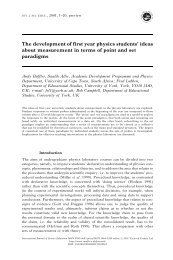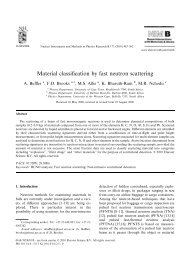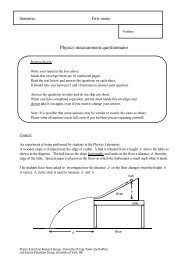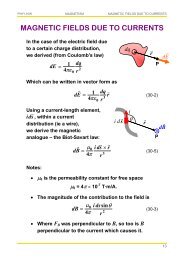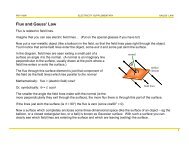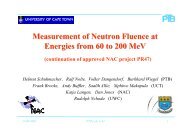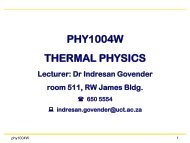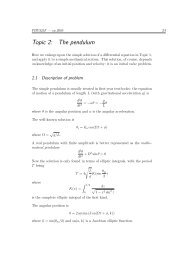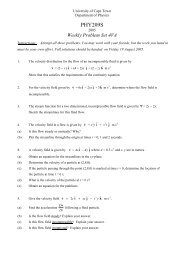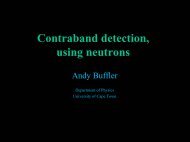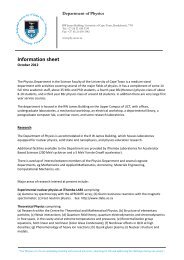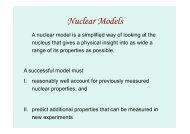PHY3022S Nuclear and Particle Physics 1 - University of Cape Town
PHY3022S Nuclear and Particle Physics 1 - University of Cape Town
PHY3022S Nuclear and Particle Physics 1 - University of Cape Town
Create successful ePaper yourself
Turn your PDF publications into a flip-book with our unique Google optimized e-Paper software.
<strong>University</strong> <strong>of</strong> <strong>Cape</strong> <strong>Town</strong><br />
Department <strong>of</strong> <strong>Physics</strong><br />
<strong>PHY3022S</strong><br />
<strong>Nuclear</strong> <strong>and</strong> <strong>Particle</strong> <strong>Physics</strong><br />
<strong>Nuclear</strong> <strong>Physics</strong> Part 1<br />
Basics<br />
Andy Buffler<br />
UCT <strong>Physics</strong><br />
<strong>and</strong>y.buffler@uct.ac.za<br />
Room 503, RW James Building<br />
1
Atomic <strong>Physics</strong><br />
(David Aschman) 20 lectures<br />
<strong>PHY3022S</strong> Course Outline<br />
<strong>Nuclear</strong> <strong>and</strong> <strong>Particle</strong> <strong>Physics</strong><br />
(Andy Buffler <strong>and</strong> Andrew Hamilton) 20 lectures<br />
Solid State <strong>Physics</strong><br />
(Mark Blumenthal) 20 lectures<br />
For nuclear <strong>and</strong> particle physics …<br />
Prescribed book is<br />
BR Martin, <strong>Nuclear</strong> <strong>and</strong> <strong>Particle</strong> <strong>Physics</strong>: An Introduction (Wiley, 2006)<br />
Also used:<br />
RJ Blin-Stoyle, <strong>Nuclear</strong> <strong>and</strong> <strong>Particle</strong> <strong>Physics</strong> (Chapman <strong>and</strong> Hall, 1991)<br />
Tutor for <strong>Nuclear</strong> <strong>Physics</strong>: Maciej Stankiewicz<br />
2
Conservation <strong>of</strong> energy <strong>and</strong> charge in e + e - production<br />
3
Periodic Table <strong>of</strong> the Elements<br />
6
The nuclear atom<br />
Chapter 1:<br />
RJ Blin-Stoyle,<br />
<strong>Nuclear</strong> <strong>and</strong> <strong>Particle</strong> <strong>Physics</strong><br />
(Chapman <strong>and</strong> Hall, 1991)<br />
7
Radioactivity - history<br />
1885 JJ Thomson discovers the electron<br />
1896 Bequerel …β-radiation from uranium salts<br />
1896 Roentgen … X-rays<br />
1898 Pierre <strong>and</strong> Marie Curie … α-radiation<br />
1900 Villard … γ-radiation
Radioactivity<br />
α-radiation:<br />
Emission <strong>of</strong> an α-particle ( 4 He nucleus) from a nucleus.<br />
Energy around 5 MeV (short range in matter).<br />
β ‒ -radiation: Electron emission in nuclear decay<br />
β + -radiation: Positron emission in nuclear decay<br />
γ-radiation:<br />
De-excitation <strong>of</strong> a nucleus from excited state to lower<br />
state (keV to MeV)<br />
10
Development <strong>of</strong> atomic theory<br />
JJ Thomson (Nobel Prize in <strong>Physics</strong>, 1906)<br />
“Plum pudding” model.<br />
Poor agreement with experiment.<br />
11
The Rutherford model<br />
Ernest Rutherford<br />
(Nobel Prize in Chemistry, 1908)<br />
12
Scattering <strong>of</strong> a 4 He nucleus <strong>of</strong>f …<br />
(a) Thomson’s atom<br />
(b) Rutherford’s atom<br />
Simulation <strong>of</strong> Rutherford scattering<br />
<strong>of</strong>f a gold nucleus<br />
13
Rutherford: “It was the most incredible event that has ever<br />
happened to me in my life. It was almost as incredible as if you<br />
fired a 15 inch shell at a piece <strong>of</strong> tissue paper <strong>and</strong> it came back<br />
<strong>and</strong> hit you.”<br />
Rutherford model (1911): The atom has a small hard central<br />
core (nucleus) where all the positive charge is concentrated.<br />
The negative charge inhabitants the nearly empty space around<br />
the nucleus.<br />
Thus most <strong>of</strong> the alpha particles migrate through the gold foil<br />
with some or no (Coulomb) interaction, but some will<br />
experience a “head-on” collision with a nucleus <strong>and</strong> return in a<br />
backwards direction.<br />
14
But there were still unanswered questions …<br />
… why does the nucleus (all positive charge) not fly apart due<br />
to Coulomb repulsion?<br />
… why do the negative charges not radiate energy, spiral<br />
inwards <strong>and</strong> collapse into the nucleus due to Coulomb<br />
attraction?<br />
… the model did also not explain existing experimental<br />
observations.<br />
15
Atomic size<br />
In a solid, assume all atoms are spherical <strong>and</strong> packed in a tight grid.<br />
For radius R, separation is 2R <strong>and</strong> volume <strong>of</strong> each atom (2R) 3 .<br />
One mole contains N A atoms <strong>and</strong> occupies volume 8N A R 3 .<br />
Volume also given by<br />
Thus<br />
R<br />
3<br />
M 10<br />
…<br />
where is density <strong>and</strong> M molar mass (in g).<br />
1<br />
3 3<br />
1 M<br />
10<br />
<br />
<br />
2 <br />
N <br />
A <br />
Gold has M<br />
…. thus<br />
<br />
197 <strong>and</strong> 19.310 kg m<br />
10<br />
R 1.310 m<br />
3 -3<br />
All atomic radii are about the same: range<br />
<br />
<br />
10<br />
0.5 2.5 10<br />
m
The radioactive decay law<br />
Radioactive decay is a statistical (r<strong>and</strong>om) process.<br />
Consider a set <strong>of</strong> identical unstable nuclei.<br />
The set will obtain N 0 = N(0) <strong>of</strong> these nuclei at t =0 ,<br />
<strong>and</strong> N(t) radioactive nuclei at time t .<br />
i.e. N(t) < N(0) because <strong>of</strong> the decay.<br />
The rate at which the nuclei decay is proportional to N(t):<br />
dN()<br />
t<br />
i.e. Nt<br />
( )<br />
dt<br />
is called the decay constant <strong>and</strong> depends on the nuclide.<br />
represents the probability that any one nucleus will decay<br />
during the next second (or any other time unit).<br />
18
For a particular set <strong>of</strong> nuclides, is the same for each<br />
nucleus, at all times.<br />
dN()<br />
t<br />
dN<br />
N()<br />
t dt<br />
dt<br />
N<br />
<br />
N () t<br />
N<br />
0<br />
dN()<br />
t<br />
<br />
Nt ()<br />
<br />
t<br />
0<br />
dt<br />
log ( ) ()<br />
N t <br />
t<br />
e<br />
N t t<br />
<br />
N (0)<br />
0 log ln<br />
Nt ()<br />
<br />
N(0)<br />
e<br />
t<br />
e<br />
Radioactive decay law:<br />
N( t) N(0)<br />
e t<br />
19
Mean life <strong>of</strong> decay<br />
: decay constant<br />
Nt ()<br />
N(0)<br />
The mean life,<br />
or lifetime,<br />
is defined to<br />
be 1<br />
<br />
N(0)<br />
e<br />
N(0)<br />
When t , N( t) ,<br />
e<br />
<br />
N()<br />
t N e t<br />
0<br />
t<br />
so the lifetime is the time taken for N(0) to drop to 1 N(0)<br />
e<br />
20
Half life <strong>of</strong> decay, T12<br />
T 12<br />
is the time taken for N(t) to drop to 1 2<br />
N(0)<br />
So at t T :<br />
12<br />
1<br />
N( t) N( T12) N(0)<br />
2<br />
T<br />
i.e. N(0) N(0)<br />
e<br />
1<br />
2<br />
T12<br />
2 e<br />
ln 2 T12<br />
ln 2 0.693 T 12<br />
0.693<br />
<br />
<br />
<br />
T 12<br />
is convenient, since when t = m<br />
e.g. after 3 half-lives, N(3 T12)<br />
<br />
12<br />
N<br />
N(0)<br />
1<br />
12<br />
14<br />
18<br />
T 12<br />
N(0)<br />
8<br />
1 2 3<br />
, N(t) is reduced to<br />
N(0)<br />
2 m<br />
21<br />
m
The decay rate<br />
<strong>of</strong>ten more interesting than<br />
Write<br />
Activity<br />
dN()<br />
t<br />
Rt () <br />
dt<br />
Nt ()<br />
dN()<br />
t<br />
R( t) N(0)<br />
e<br />
dt<br />
t<br />
or activity <strong>of</strong> the sample is<br />
itself.<br />
or<br />
R( t) R(0)<br />
e t<br />
where R(0) N(0)<br />
The number <strong>of</strong> disintegrations (decays) per second also reduces<br />
exponentially with decay constant . <br />
SI units <strong>of</strong> activity: 1 bequerel (Bq) = 1 decay per second<br />
Older unit: 1 curie (Ci) = 3.7 10 10 decays per second<br />
22
For a decay chain A → B → C →<br />
A<br />
N ( ) (0) t<br />
A<br />
t N<br />
A<br />
e <br />
A<br />
At<br />
B<br />
For a two stage decay sequence NB( t) N<br />
A(0) e e<br />
B<br />
<br />
A<br />
For a three stage decay sequence<br />
<br />
t<br />
<br />
t<br />
e e e<br />
NC ( t) <br />
A BN<br />
A(0)<br />
<br />
<br />
<br />
A B<br />
Ct<br />
<br />
B A C A A B C B A C B C<br />
t
Interaction <strong>of</strong> radiation with matter<br />
24
Electromagnetic radiation<br />
Three primary processes <strong>of</strong> interaction with matter:<br />
Photoelectric effect, Compton scattering, Pair production<br />
25
7.6 cm x 7.6 cm NaI 1.9 cm x 0.5 cm HPGe<br />
26
Probability per unit length<br />
for removal <strong>of</strong> a photon<br />
Linear absorption coefficient μ<br />
Fractional loss in intensity:<br />
I( x)<br />
I e x<br />
0<br />
Mass attenuation coefficient:<br />
<br />
<br />
27
Discovery <strong>of</strong> the neutron<br />
James Chadwick, 1932<br />
Outside the nucleus, free neutrons are unstable <strong>and</strong> have a half<br />
life <strong>of</strong> 611.0 ± 1.0 s.<br />
<br />
n p e <br />
e<br />
28
Neutrons<br />
Uncharged, do not interact via Coulomb forces<br />
Interact (via collisions or reactions)<br />
with the nuclei <strong>of</strong> absorbing material<br />
Secondary radiation is almost always heavy charged particles<br />
Probability <strong>of</strong> interaction given by a cross section σ (see later)<br />
Fractional loss in intensity <strong>of</strong> a neutron beam irradiating<br />
a material <strong>of</strong> N nuclei per unit volume, <strong>and</strong> thickness x:<br />
N<br />
I( x)<br />
I e <br />
0<br />
x<br />
29
Pulse height spectrum<br />
n<br />
Organic scintillator<br />
p<br />
PMT<br />
n<br />
Energy spectrum<br />
<strong>of</strong> recoil protons<br />
30
Frank Brooks (1931 – 2012) UCT Pr<strong>of</strong>essor <strong>of</strong> <strong>Nuclear</strong> <strong>Physics</strong><br />
… developed in the early 1960s the first<br />
practical systems <strong>of</strong> pulse shape<br />
discrimination (PSD) which allows the<br />
identification <strong>of</strong> different types <strong>of</strong> charged<br />
particles in certain scintillator detectors by<br />
means <strong>of</strong> the characteristics <strong>of</strong> the<br />
scintillation decay.<br />
gammas<br />
PSD in a 5 cm x 5 cm<br />
organic liquid<br />
scintillator<br />
neutrons<br />
AmBe source<br />
Beam <strong>of</strong> 66 MeV neutrons
Charged particles<br />
The linear stopping power (or specific energy loss) for<br />
charged particles in a given absorber ‒dE/dx can be<br />
calculated using the Bethe-Bloch formula …<br />
… better via “Monte Carlo” method<br />
… see www.srim.org<br />
32
Specific energy loss in air<br />
33
“Bragg peak”<br />
34
Radiation units<br />
Activity: the rate <strong>of</strong> spontaneous decay transitions in a sample …<br />
SI unit:<br />
1 bequerel (Bq) = 1 decay per second<br />
Traditional unit: 1 curie (Ci) = 3.7 × 10 10 Bq<br />
Exposure: quantity <strong>of</strong> radiation to which an object is<br />
exposed which is the ionization that the radiation would<br />
produce in dry air …<br />
SI unit:<br />
1 roentgen (R) = 2.58 × 10 -4 C/kg in dry air<br />
… amount <strong>of</strong> radiation which delivers 8.78 mJ<br />
<strong>of</strong> energy to 1 kg <strong>of</strong> dry air<br />
“Exposure” (<strong>and</strong> roentgens) seldom used nowadays …<br />
35
Absorbed dose: a measure <strong>of</strong> the energy deposited in a medium<br />
by ionizing radiation per unit mass …<br />
SI unit: 1 gray (Gy) = 1 J kg -1<br />
Traditional unit: 1 rad = 0.01 gray<br />
The absorbed dose depends not only on the incident radiation but<br />
also on the absorbing material: a s<strong>of</strong>t X-ray beam may deposit four<br />
times more dose in bone than in air, or none at all in a vacuum.<br />
Kerma: “kinetic energy released in matter” … the sum <strong>of</strong> the<br />
initial kinetic energies <strong>of</strong> all the charged particles liberated by<br />
uncharged radiation (i.e., indirectly ionizing radiation such<br />
as photons <strong>and</strong> neutrons) in a sample <strong>of</strong> matter, per unit mass <strong>of</strong><br />
the sample … kerma always greater than absorbed dose since<br />
some <strong>of</strong> the energy escapes from the absorbing volume in the<br />
form <strong>of</strong> bremsstrahlung x-rays or fast moving electrons.<br />
SI unit: grey (G)<br />
36
Equivalent dose: a computed average measure <strong>of</strong> the radiation<br />
absorbed by a fixed mass <strong>of</strong> biological tissue, that attempts to<br />
account for the different biological damage potential <strong>of</strong> different<br />
types <strong>of</strong> ionizing radiation. It is therefore a less fundamental<br />
quantity than the total radiation energy absorbed per mass (the<br />
absorbed dose), but is a more significant quantity for assessing<br />
the health risk <strong>of</strong> radiation exposure.<br />
SI unit: 1 sievert (Sv) = 1 J kg -1<br />
Traditional unit: 1 rem = 0.01 Sv<br />
equivalent dose (H) = absorbed dose (D)<br />
× radiation weighting factor (W R )<br />
37
equivalent dose (H) = absorbed dose (D)<br />
× radiation weighting factor (W R )<br />
Radiation weighting factors (legislated):<br />
Radiation<br />
W R<br />
X-rays, gamma rays, electrons, muons 1<br />
Neutrons: thermal 5<br />
Neutrons: < 0.1 MeV 10<br />
Neutrons: < 2 MeV 20<br />
Neutrons: > 2 MeV 10<br />
High energy protons 5<br />
Alpha particles, fission fragments, heavy nuclei 20<br />
One sievert <strong>of</strong> two different radiations produces the same<br />
biological effect (more or less).<br />
“Dose rate” also useful … equivalent dose per unit time.<br />
38
http://xkcd.com/radiation/<br />
39
<strong>Nuclear</strong> phenomenology<br />
nucleus positive core <strong>of</strong> the atom<br />
discovered by Rutherford in -scattering experiments<br />
… almost all the mass <strong>of</strong> the atom concentrated in the nucleus<br />
… the nucleus consists <strong>of</strong><br />
A nucleons Z protons N neutrons<br />
held together by<br />
strong nuclear forces<br />
positively<br />
charged<br />
no charge<br />
43
• nuclide: a particular combination <strong>of</strong> protons <strong>and</strong> neutrons<br />
• nuclides are characterized <strong>and</strong> represented by:<br />
<br />
<br />
<br />
A A A<br />
AZ , X X X X A<br />
atomic number<br />
mass number<br />
<br />
Z Z N<br />
60 60 60<br />
27 27 33<br />
X: chemical symbol<br />
e.g. 60,27 Co Co Co Co 60<br />
A Z N<br />
neutron number<br />
• isotopes: Nuclides with the same Z<br />
• isotones: Nuclides with the same N<br />
• isobars: Nuclides with the same A<br />
35 36<br />
e.g.<br />
17Cl 17Cl<br />
40 39<br />
e.g.<br />
20Ca 19K<br />
20 20<br />
e.g.<br />
9F 10<br />
Ne<br />
44
<strong>Nuclear</strong> <strong>and</strong> atomic masses<br />
exactly<br />
Mass <strong>of</strong> 1 neutral atom <strong>of</strong> 12 6 C<br />
12.0000<br />
u<br />
One mole <strong>of</strong> a substance contains Avogadro’s number,<br />
N A = 6.02310 23 atoms (or molecules)<br />
… giving 1 u = 1.66110 -27<br />
unified mass unit<br />
One mole <strong>of</strong> a substance <strong>of</strong> molecular weight M u is M 10 -3 kg<br />
Then 0.012 kg <strong>of</strong> 12 C contains N A atoms <strong>of</strong> mass 12 u …<br />
kg<br />
Then<br />
Eu<br />
<br />
27 <br />
8 -1<br />
1.66110 kg 310 m s <br />
<br />
19 -1<br />
1.610 J eV <br />
<br />
2<br />
u c<br />
931.5 MeV<br />
2<br />
So we can write 1 u = 931.5 MeV/c 2<br />
46
Energy equivalent masses:<br />
M p = 1.007276 u = 938 MeV<br />
M n = 1.008665 u = 940 MeV<br />
M e = 0.0005486 u = 0.511 MeV<br />
47
<strong>Nuclear</strong> sizes <strong>and</strong> shapes<br />
Size <strong>and</strong> shape <strong>of</strong> a nucleus can be found from scattering experiments<br />
… use electrons to learn about charge distribution<br />
… <strong>and</strong> hadrons (<strong>of</strong>ten neutrons) to learn about matter distribution<br />
Charge distribution<br />
In principle the charge distribution <strong>of</strong> a nucleus may be<br />
obtained from the measurements <strong>of</strong> the differential cross<br />
section <strong>of</strong> electron scattering, but more reliable<br />
determinations are obtained from numerical solutions <strong>of</strong> the<br />
Dirac equation fitted to experimental data …<br />
48
Radial charge distributions () r <strong>of</strong> various nuclei, in units<br />
<strong>of</strong> e fm −3 ch<br />
; the thickness <strong>of</strong> the curves near r = 0 is a measure<br />
<strong>of</strong> the uncertainty in () r ch .<br />
0<br />
() ch<br />
ch r <br />
ra<br />
b<br />
1<br />
e<br />
“Saxon Woods”<br />
For medium<br />
<strong>and</strong> heavy nuclei …<br />
a<br />
<br />
13<br />
1.07 A fm<br />
b 0.54 fm<br />
0<br />
ch 0.06 to 0.08<br />
49
Mass distribution<br />
Almost identical nuclear density in the nuclear interior <strong>of</strong> all<br />
nuclei.<br />
ch<br />
0<br />
… the decrease in with increasing A is compensated by<br />
the increase in A/Z with increasing A<br />
Interior nuclear density then<br />
nuclear 0.17 nucleons / fm<br />
3<br />
<strong>and</strong> for medium <strong>and</strong> heavy nuclei …<br />
R<br />
13<br />
nuclear<br />
1.2 A fm<br />
50
Elastic differential cross-sections for 52 MeV deuterons on 54 Fe<br />
51
Differential cross-sections<br />
(normalized to the<br />
Rutherford cross-section)<br />
for the elastic scattering <strong>of</strong><br />
30.3 MeV protons, for a<br />
range <strong>of</strong> nuclei compared<br />
with optical model<br />
calculations; the solid <strong>and</strong><br />
dashed lines represent the<br />
results using two different<br />
potentials.<br />
52
Periodic Table <strong>of</strong> the Elements<br />
53
<strong>Nuclear</strong> binding energy<br />
Use atomic masses to define the mass deficit / defect / excess<br />
M ( Z, A) M ( Z, A) Z( M m ) NM<br />
Define the nuclear binding energy to be:<br />
p e n<br />
B<br />
M ( Z, A)<br />
c<br />
2<br />
Measure nuclear masses<br />
with a mass spectrometer<br />
54
… B/A is the binding energy per nucleon for a particular nuclide.<br />
Plotting B/A versus A gives the binding energy curve...<br />
Average<br />
binding<br />
energy<br />
per<br />
nucleon<br />
(MeV)<br />
Mass number A<br />
Note that the region <strong>of</strong> greatest stability is at a maximum <strong>of</strong><br />
8.7 MeV per nucleon, occurring at A = 50 – 80.<br />
55
Example: Binding energy <strong>of</strong> the deuteron.<br />
What is the binding energy <strong>of</strong> the deuteron if<br />
B<br />
D<br />
M c<br />
where<br />
D<br />
2<br />
M D = 2.013553 u<br />
M p = 1.007276 u<br />
M n = 1.008665 u<br />
<br />
<br />
M M M M 0.002388 u<br />
D p n D<br />
MeV <br />
B u<br />
c <br />
uc <br />
2<br />
D<br />
0.002388 931.5 2.224 MeV<br />
2 <br />
n – p capture:<br />
n + p d + g<br />
2.224 MeV<br />
57
Stability <strong>of</strong> nuclides<br />
Not all nuclides are stable. Unstable nuclei decay spontaneously<br />
to become stable.<br />
i.e. emit particles<br />
e.g. Gold has 30 isotopes ( 175 Au 204 Au). Only 197 Au is stable.<br />
The other 29 isotopes are radioactive nuclides (radionuclides)<br />
Organising the nuclides<br />
The periodic table shows the most common or most stable isotope<br />
<strong>of</strong> each element. Usefulness limited since different isotopes have<br />
very different nuclear properties.<br />
The nuclidic chart shows all known nuclides<br />
… is a plot <strong>of</strong> Z vs. N …<br />
58
Stable nuclides shaded dark<br />
Radioactive nuclides<br />
shaded light<br />
For a stable nuclides<br />
with N 20, N Z<br />
This increases to N 1.5 Z,<br />
for N 120<br />
59
“Valley <strong>of</strong> stability”<br />
61
–decay<br />
<strong>Nuclear</strong> decay<br />
4<br />
helium nucleus<br />
2He2<br />
… the unstable “parent” nucleus emits an -particle.<br />
A<br />
Z<br />
X Y He<br />
A4 4<br />
Z2 2<br />
b –decay<br />
b <br />
an electron<br />
… occurs when n p inside a neutron-rich nuclide<br />
X<br />
Y e <br />
A<br />
A<br />
<br />
Z Z1 N1<br />
e<br />
Possible when M ( Z, A) M ( Z 1,<br />
A)<br />
63
–decay<br />
b <br />
X<br />
a positron<br />
… occurs when p n inside a proton-rich nuclide<br />
Y e <br />
A<br />
A<br />
<br />
Z Z1 N1<br />
e<br />
Possible when M ( Z, A) M ( Z 1, A) 2m<br />
e<br />
Electron capture<br />
A nucleus captures an atomic electron which has ventured<br />
too close to the nucleus<br />
X e Y <br />
<br />
A<br />
<br />
A<br />
Z N Z1 N1<br />
e<br />
Possible when M ( Z, A) M ( Z 1, A)<br />
<br />
where is the excitation energy <strong>of</strong> the atomic shell<br />
<strong>of</strong> the daughter nucleus<br />
64
Energy released in radioactive decay<br />
In nuclear decay, binding energy is released, becoming<br />
kinetic energy <strong>of</strong> the decay products…<br />
Q<br />
<br />
<br />
energy released in the decay<br />
mass mass<br />
c<br />
2<br />
before<br />
Q > 0 is a condition for the decay to occur.<br />
A<br />
A4 4<br />
For example, consider the –decay: X Y He<br />
Z<br />
after<br />
Z2 2<br />
The Q–value or disintegration energy is<br />
2 2 2<br />
Q M c ( M c M c )<br />
This can be shown to be the same as:<br />
Q B B B<br />
X<br />
Y<br />
<br />
B B B<br />
<br />
( 4) 4 <br />
A A<br />
4 4 <br />
X<br />
Y<br />
A A <br />
X<br />
Y<br />
65
Ground <strong>and</strong> excited states <strong>of</strong> nuclei<br />
66
Gamma decay<br />
Decay is a ”step” towards stability. Nuclei, like atoms have<br />
discrete energy states. Excited nuclei decay by transitions in<br />
which high energy photons (g-rays) are emitted.<br />
A *<br />
A<br />
ZX<br />
<br />
ZX<br />
g<br />
excited state<br />
e.g. the decay <strong>of</strong> 60<br />
27 Co:<br />
b <br />
g<br />
g<br />
2.50 MeV<br />
(1.17 MeV)<br />
1.33 MeV<br />
(1.33 MeV)<br />
0<br />
60<br />
Co is therefore a source <strong>of</strong> both g s <strong>and</strong> 27 b– s,<br />
both radiation exhibiting a half life <strong>of</strong> 5.3 years.<br />
67
Natural radioactivity<br />
69
Angular momentum <strong>of</strong> a nucleon<br />
1<br />
Nucleons are fermions, therefore spin quantum number s 2<br />
Eigenvalue <strong>of</strong><br />
Eigenvalue <strong>of</strong><br />
2 1 1<br />
s is 2<br />
2 21<br />
sz<br />
is<br />
1<br />
2 <br />
Nucleon has orbital angular momentum quantum number 0,1,2,...<br />
Eigenvalue <strong>of</strong><br />
Eigenvalue <strong>of</strong><br />
Add spin <strong>and</strong> orbital angular momentum vectorially to get<br />
total angular momentum j l s<br />
Eigenvalue <strong>of</strong><br />
Eigenvalue <strong>of</strong><br />
is<br />
2<br />
l 2<br />
z<br />
is<br />
is<br />
m<br />
1<br />
j j1<br />
2<br />
j 2<br />
jz<br />
is<br />
m<br />
j<br />
m l,...,0,..., 1,<br />
<br />
m j,...,0,..., j 1,<br />
j<br />
j<br />
71
Angular momentum <strong>of</strong> a nucleus<br />
Add all spins <strong>of</strong> nucleons vectorially to get total nuclear spin S.<br />
Add all orbital angular momenta vectorially to get total<br />
orbital angular momentum L.<br />
Add total spin <strong>and</strong> total orbital angular momentum vectorially<br />
to get total angular momentum (or nuclear spin)<br />
J L S<br />
Write nucleus wavefunction as<br />
JM<br />
Therefore<br />
<br />
<br />
J 2 1<br />
2<br />
JM<br />
J J JM<br />
<strong>and</strong> JzJM M JM<br />
where<br />
M J, J 1,...,0,..., J 1,<br />
J<br />
72
Parity<br />
Parity is the transformation<br />
r<br />
r<br />
x<br />
x <br />
Pˆ , t P , t<br />
The intrinsic parity <strong>of</strong> a single proton <strong>and</strong> a single neutron<br />
is defined as +1<br />
Under the parity transformation … PY ˆ , 1 Y ,<br />
<br />
Therefore for a single particle nuclear state P 1<br />
Total parity <strong>of</strong> a multiparticle state is the product <strong>of</strong> parities <strong>of</strong><br />
individual particles.<br />
m<br />
m<br />
A pair <strong>of</strong> nucleons with the same l have combined parity <strong>of</strong> +1<br />
… therefore parity <strong>of</strong> a nucleus depends on the parity <strong>of</strong> the last<br />
unpaired proton <strong>and</strong>/or neutron.<br />
73
Spin <strong>and</strong> Parity<br />
Individual <strong>and</strong>/or collective motions <strong>of</strong> nucleons (determined<br />
by nuclear structure <strong>and</strong> dynamics) determine symmetry <strong>and</strong><br />
other properties <strong>of</strong> the nuclear wave function.<br />
A nuclear state is labelled with both its spin <strong>and</strong> parity in the<br />
form J e.g.<br />
1 <br />
2<br />
,1 ,0 ,...<br />
Some observations for ground states:<br />
Even A nuclei have<br />
J 0,1,2,...<br />
Odd A nuclei have<br />
J <br />
1 3 5<br />
2<br />
, 2<br />
, 2<br />
,...<br />
All even-even nuclei have J 0<br />
<br />
74
Recall … the magnetic moment <strong>of</strong> the electron<br />
Classically for an electron <strong>of</strong> charge e <strong>and</strong> mass m orbiting with<br />
angular momentum L … associated orbital magnetic moment is<br />
e<br />
μL<br />
L<br />
2m<br />
And similarly define an intrinsic (spin) magnetic moment<br />
e<br />
μ g s<br />
2 m<br />
where g-factor = 2.0023192 (or 2.000000 from Dirac)<br />
Actual value <strong>of</strong> electron intrinsic magnetic moment is an<br />
eigenvalue <strong>of</strong> when electron is in m substate.<br />
1<br />
z<br />
s 2<br />
e e<br />
1 1 1<br />
2 g 2 g 2<br />
gB<br />
2m<br />
2m<br />
where the Bohr magneton B e 2m<br />
= 9.274 × 10 -24 J T -1<br />
75
<strong>Nuclear</strong> magnetic dipole moments<br />
Both the proton <strong>and</strong> the neutron have an intrinsic magnetic<br />
moment … <strong>and</strong> since the proton is charged, it can also produce a<br />
magnetic moment when in orbital motion.<br />
Write the magnetic moments for spin up protons <strong>and</strong> neutrons as<br />
or<br />
Measure<br />
Then<br />
<br />
p<br />
e<br />
1 1<br />
<br />
p<br />
2<br />
g<br />
p<br />
n<br />
2<br />
gn<br />
2M<br />
p<br />
2<br />
<br />
<br />
g<br />
<br />
1<br />
p 2 p N<br />
<br />
<br />
g<br />
e<br />
M<br />
<br />
p<br />
1<br />
n 2 n N<br />
where the nuclear magneton e 2M<br />
= 5.05078× 10 -27 J T -1<br />
g 5.5856 <strong>and</strong> g 3.8262<br />
p<br />
Note that<br />
2.7928<br />
<strong>and</strong> 1.9131<br />
<br />
p<br />
N<br />
32<br />
n<br />
N<br />
n<br />
n<br />
p<br />
(predicted by quark model)<br />
N<br />
76
Magnetic moments <strong>of</strong> nuclei involve spin <strong>and</strong> orbital<br />
component, <strong>and</strong> are indictors <strong>of</strong> structure.<br />
For a nucleus … the intrinsic magnetic moments <strong>of</strong> the<br />
constituent protons <strong>and</strong> neutrons will contribute to the total<br />
magnetic moment … with further contributions from any<br />
orbital motion <strong>of</strong> the protons.<br />
Then<br />
<br />
<br />
Jg<br />
<br />
J J N<br />
g J<br />
where is the nuclear g-factor … the ratio <strong>of</strong> the magnetic<br />
moment in nuclear magnetons to the total angular momentum<br />
quantum number for the nuclear (or particle) state.<br />
Find<br />
0<br />
for all J = 0 ground states (why?)<br />
77
<strong>Nuclear</strong> electric quadrupole moments<br />
Define quadrupole moment as ( ) 3 2 2<br />
0 ch<br />
r<br />
Q z r dV<br />
… with z-axis along symmetry axis defined by nuclear spin.<br />
Then can write<br />
<br />
<br />
2 2<br />
Q0 Z 3 z r <strong>and</strong> has units <strong>of</strong> barns.<br />
2 2 2 2<br />
z<br />
where r x y z<br />
For a spherical nucleus:<br />
z<br />
r <strong>and</strong> thus Q0 0<br />
2 1 2<br />
3<br />
For a non-spherical nucleus:<br />
z<br />
<br />
r<br />
2 1 2<br />
3<br />
z<br />
z<br />
r Prolate ellipsoid Q0 0<br />
2 1 2<br />
3<br />
z<br />
z<br />
r Oblate ellipsoid Q0 0<br />
2 1 2<br />
3<br />
Find Q0 0<br />
1<br />
for all J = 0 <strong>and</strong> J 2<br />
ground states (why?)<br />
78
A nucleus may be deformed<br />
away from spherical into a<br />
(a) prolate shape (rugby ball)<br />
or<br />
(b) (b) oblate (flying saucer)<br />
79
8 May 2013<br />
A representation <strong>of</strong> the radium-224 nucleus. The<br />
atomic nucleus is a many-body quantum system with a<br />
shape determined by the number <strong>of</strong> nucleons that it<br />
contains <strong>and</strong> the interactions between them. Most <strong>of</strong><br />
the several thous<strong>and</strong> known stable <strong>and</strong> radioactive<br />
atomic nuclei, with differing numbers <strong>of</strong> protons <strong>and</strong><br />
neutrons, are spherical or rugby-ball shaped. But there<br />
is circumstantial evidence that some heavy, unstable<br />
nuclides are distorted into a pear shape through the<br />
phenomenon <strong>of</strong> octupole deformation. Samples <strong>of</strong><br />
these rare atomic species can be accelerated to 8% <strong>of</strong><br />
the speed <strong>of</strong> light in the REX-ISOLDE facility at<br />
CERN, <strong>and</strong> now Coulomb excitation experiments on<br />
beams <strong>of</strong> the short-lived isotopes radium-224 <strong>and</strong><br />
radon-220 have demonstrated clear octupole<br />
deformation in the former. The results make it possible<br />
to discriminate between the various theoretical models<br />
<strong>of</strong> octupole-deformed nuclei, <strong>and</strong> are also relevant to<br />
the pursuit <strong>of</strong> physics beyond the st<strong>and</strong>ard model.<br />
80
The nucleon-nucleon potential<br />
Martin<br />
7.1<br />
We infer that the N-N force must be …<br />
1. Short range (from Rutherford scattering)<br />
2. Attractive at short range (to bind nucleons in<br />
nuclei)<br />
3. Strong relative to Coulomb (to bind protons)<br />
4. Repulsive at very short range (i.e. must<br />
“saturate” (to prevent collapse <strong>of</strong> all nuclei to<br />
the dimension <strong>of</strong> the force range)<br />
V()<br />
r<br />
F r<br />
81
Electrostatic <strong>and</strong> gravitational potential is long range V 1 r .<br />
Near constancy <strong>of</strong> nuclear binding energy per nucleon B/A means<br />
that each nucleon feels only the effect <strong>of</strong> a few neighbours.<br />
This is called saturation … implies the strong inter-nucleon<br />
potential is short range.<br />
Range is <strong>of</strong> order <strong>of</strong> the 1.8 fm inter-nucleon separation.<br />
Since volume A , nuclei do not collapse, there is a very<br />
short range repulsive component. Reminiscent <strong>of</strong> interatomic<br />
potential in molecules. Is nuclear physics just quark chemistry?<br />
Depth <strong>of</strong> potential is <strong>of</strong> order <strong>of</strong> binding energy,<br />
perhaps tens <strong>of</strong> MeV.<br />
82
The deuteron<br />
The deuteron 2 H is the bound state <strong>of</strong> a neutron <strong>and</strong> a proton.<br />
Experimental properties:<br />
Binding energy B = 2.2245 ± 0.0002 MeV<br />
Angular momentum <strong>and</strong> parity J π = 1 +<br />
Magnetic dipole moment μ D = 0.8575 nuclear magnetons<br />
Electric quadrupole moment Q D = 0.00282 × 10 -28 m 2<br />
Deuteron has very small binding energy, <strong>and</strong> no excited states.<br />
Also ( 1.91 2.79) 0.88<br />
n p N N<br />
And with very small Q D , infer that deuteron is in L = 0 state<br />
where L l p<br />
ln<br />
83
Deuteron ground state L = 0<br />
Then since J L S<br />
… J = 1 (measured)<br />
… implies proton <strong>and</strong> neutron spins are aligned (S = 1)<br />
Thus using the st<strong>and</strong>ard spectroscopic notation 2S<br />
1 L<br />
J<br />
where L = S, P, D, F, G, H<br />
for L = 0, 1, 2, 3, 4 …<br />
… the deuteron has a triplet ground state 3 S1<br />
84



